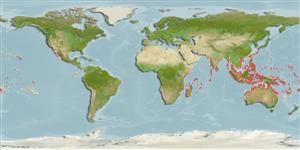>
Blenniiformes (Blennies) >
Blenniidae (Combtooth blennies) > Salariinae
Etymology: Ecsenius: Greek, exenios, -os, -on = uncontrolled, immoderate.
More on author: Day.
Environment: milieu / climate zone / depth range / distribution range
Écologie
marin récifal; profondeur 1 - 25 m (Ref. 9710). Tropical; 30°N - 30°S
Indo-Pacific: Maldives to the Phoenix Islands, north to Ryukyu Islands, south to the southern Great Barrier Reef; throughout Micronesia.
Taille / Poids / Âge
Maturity: Lm ? range ? - ? cm
Max length : 11.0 cm TL mâle / non sexé; (Ref. 2334)
Description synthétique
Clés d'identification | Morphologie | Morphométrie
Épines dorsales (Total) : 11 - 12; Rayons mous dorsaux (Total) : 15 - 18; Épines anales: 2; Rayons mous anaux: 17 - 21. Occurs in three color phases: one black anteriorly and yellow posteriorly (bicolor phase), the others black dorsally with a broad white lateral band and dusky belly with or without a yellow tail.
Found solitary in abandoned tubes (Ref. 90102). Inhabit clear lagoon and seaward reefs with mixed corals and algae-covered rocks. Oviparous. Eggs are demersal and adhesive (Ref. 205), and are attached to the substrate via a filamentous, adhesive pad or pedestal (Ref. 94114). Larvae are planktonic, often found in shallow, coastal waters (Ref. 94114).
Life cycle and mating behavior
Maturité | Reproduction | Frai | Œufs | Fécondité | Larves
Distinct pairing (Ref. 205).
Springer, V.G., 1988. The Indo-Pacific blenniid fish genus Ecsenius. Smithson. Contrib. Zool. (465):134 p. (Ref. 5296)
Statut dans la liste rouge de l'IUCN (Ref. 130435: Version 2024-1)
Menace pour l'homme
Harmless
Utilisations par l'homme
Pêcheries: commercial; Aquarium: Commercial
Outils
Articles particuliers
Télécharger en XML
Sources Internet
Estimates based on models
Preferred temperature (Ref.
123201): 25.4 - 29.3, mean 28.5 °C (based on 2924 cells).
Phylogenetic diversity index (Ref.
82804): PD
50 = 0.5000 [Uniqueness, from 0.5 = low to 2.0 = high].
Bayesian length-weight: a=0.00851 (0.00469 - 0.01544), b=2.86 (2.71 - 3.01), in cm total length, based on LWR estimates for this species & (Sub)family-body (Ref.
93245).
Niveau trophique (Ref.
69278): 2.0 ±0.00 se; based on food items.
Résilience (Ref.
120179): Haut, temps minimum de doublement de population inférieur à 15 mois (Preliminary K or Fecundity.).
Fishing Vulnerability (Ref.
59153): Low vulnerability (10 of 100).
Nutrients (Ref.
124155): Calcium = 141 [69, 241] mg/100g; Iron = 0.821 [0.470, 1.439] mg/100g; Protein = 17.8 [16.6, 19.0] %; Omega3 = 0.0849 [, ] g/100g; Selenium = 26.9 [12.6, 60.7] μg/100g; VitaminA = 106 [26, 445] μg/100g; Zinc = 2.51 [1.64, 3.64] mg/100g (wet weight);
